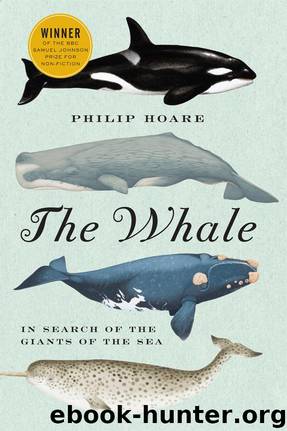The Whale by Philip Hoare

Author:Philip Hoare
Language: eng
Format: mobi, epub
ISBN: 9780061992612
Publisher: HarperCollins
Published: 2010-07-11T10:00:00+00:00
NEGRO SLAVERY
ABOLISHED
1 AUGUST
MDCCCXXXIV
–although it faces another building, one that belies the city’s claim to manumission.
Passing through the double doors with their polished brass fingerplates, I follow a sombre corridor over which hangs a skeleton, showing the way, just as I can hear a strange sound rising to a stifled focus, sometimes like a choirboy, sometimes like a trapped dog, luring me on, just as all the sounds I ever heard are compressed into one continuous noise in my head. The lighting is barely brighter in the room beyond. There is a bench, although not for public use. It is built from the bones of a whale: blade bones for the seat, ribs for the back and arms. Next to it is a hat stand created from a narwhal’s tusk nailed to a wooden base.
On the far wall of this macabre salon hang a pair of portraits both labelled, confusingly, William Scoresby. In the first, a rotund man points over a homely cottage to a ship in the distance; with his white waistcoat, belly and ruddy face, he might be a bluff farmer, rather than a reaper of the sea. The second picture shows his son in starched collar and stock; his are the refined features of a man of the Enlightenment. Between them, these two Scoresbys–one a lifelong merchantman, the other destined to be a fellow of the Royal Society–preside over a collection whose enthusiasm for its subject has faded over the years, like a stamp album put away in the attic, partly from embarrassment at such youthful and compulsive fervour.
The museum’s displays are contrived to resemble a ship’s superstructure. Everything seems subfusc. Set into the bulwarks are framed photographs, backlit to give them life, although one might almost wish they weren’t. Sepia ghosts projected out of the ether, Yorkshire’s hardy sons labour in the Arctic, in scenes as industrial as any in Bradford’s mills. Tall ships stand glamorously rigged in the ancient sunlight, while their workers’ faces stare out, stilled in the moment.
Above them, curious souvenirs are caught in the cordage. Hauled up the mainmast is the sleek carcase of a narwhal, its leopard spots losing their sheen; its tusk points downwards like a dart, about to impale itself in the deck below. A sailor saunters by this lynching, adjusting his hat for the photographer’s lens.
From another chain hangs another prize: a polar bear, caught up at its waist like a wet fur rug. It dangles snout-heavy, claws unsheathed as though only just yanked off the ice as it pawed at the water for fish. Behind it, the ship’s laundry flutters in the breeze. A third photograph, almost unbearably sad, shows a young bear still clinging to its mother’s dead body. Destined for life in a zoo, cubs were brought back in barrels barred at the top. Adults were chained to the mast like dogs. Sailors feared them more than whales: Horatio Nelson, who sailed to the Arctic on the unpropitiously named HMS Carcass in 1773, nearly died when he tried to kill a polar bear as a prize for his father.
Download
This site does not store any files on its server. We only index and link to content provided by other sites. Please contact the content providers to delete copyright contents if any and email us, we'll remove relevant links or contents immediately.
The Lonely City by Olivia Laing(4139)
Animal Frequency by Melissa Alvarez(3770)
All Creatures Great and Small by James Herriot(3539)
Walking by Henry David Thoreau(3244)
Exit West by Mohsin Hamid(3210)
Origin Story: A Big History of Everything by David Christian(3151)
COSMOS by Carl Sagan(2967)
How to Read Water: Clues and Patterns from Puddles to the Sea (Natural Navigation) by Tristan Gooley(2893)
Hedgerow by John Wright(2790)
The Inner Life of Animals by Peter Wohlleben(2780)
Origin Story by David Christian(2701)
How to Read Nature by Tristan Gooley(2675)
Project Animal Farm: An Accidental Journey into the Secret World of Farming and the Truth About Our Food by Sonia Faruqi(2672)
How to Do Nothing by Jenny Odell(2658)
Water by Ian Miller(2608)
A Forest Journey by John Perlin(2597)
The Plant Messiah by Carlos Magdalena(2468)
A Wilder Time by William E. Glassley(2373)
Forests: A Very Short Introduction by Jaboury Ghazoul(2347)
